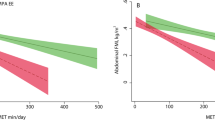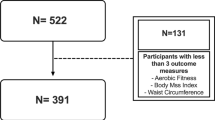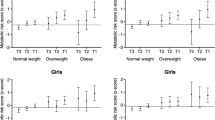Abstract
Background:
Existing knowledge on associations of physical activity (PA) and sedentary behavior (SB) with body composition and physical fitness in preschoolers is limited.
Objective:
To examine associations of PA and SB with body composition and physical fitness in healthy Swedish 4-year-old children.
Methods:
We utilized baseline data collected in 2014 for the population-based MINISTOP trial (n=307). Light-intensity PA (LPA), moderate-intensity PA (MPA), vigorous-intensity PA (VPA), moderate-to-vigorous PA (MVPA) and SB were measured using accelerometry (ActiGraph-wGT3x-BT). Body composition was measured using air-displacement plethysmography, and physical fitness (that is, cardiorespiratory fitness, lower and upper body muscular strength and motor fitness) was measured using the PREFIT fitness test battery. Multiple linear regression models adjusted for relevant confounders, and in addition, isotemporal substitution models were applied.
Results:
Greater MVPA was associated with lower fat mass percent (%FM, P=0.015), and greater VPA and MVPA were associated with higher fat-free mass index (FFMI, P=0.002 and P=0.011). In addition, greater VPA and MVPA were associated with higher scores for all physical fitness tests (P=0.042 to P<0.001). The results for MVPA were primarily due to VPA. SB was associated with weaker handgrip strength (P=0.031) when PA was not adjusted, but after adjusting also for VPA, the significant association disappeared (P=0.25). Substituting 5 min per day of SB, LPA or MPA with 5 min per day of VPA was associated with higher FFMI and better scores for cardiorespiratory fitness and motor fitness. Correspondingly, substituting 5 min per day of VPA with SB or LPA was associated with weaker performance for lower muscular strength.
Conclusions:
Time spent on VPA was associated with higher FFMI and better physical fitness. The results suggest that promoting VPA may be important to improve childhood body composition and physical fitness already at an early age.
This is a preview of subscription content, access via your institution
Access options
Subscribe to this journal
Receive 12 print issues and online access
$259.00 per year
only $21.58 per issue
Buy this article
- Purchase on Springer Link
- Instant access to full article PDF
Prices may be subject to local taxes which are calculated during checkout
Similar content being viewed by others
References
World Health Organization. World Health Statistics 2015. Available at: http://apps.who.int/ (accessed 1 August 2015).
Pulgarón ER . Childhood obesity: a review of increased risk for physical and psychological comorbidities. Clin Ther 2013; 35: A18–A32.
Nader PR, O'Brien M, Houts R, Bradley R, Belsky J, Crosnoe R et al. National Institute of Child Health and Human Development Early Child Care Research Network. Identifying risk for obesity in early childhood. Pediatrics 2006; 118: e594–e601.
Collings PJ, Brage S, Ridgway CL, Harvey NC, Godfrey KM, Inskip HM et al. Physical activity intensity, sedentary time, and body composition in preschoolers. Am J Clin Nutr 2013; 97: 1020–1028.
Metallinos-Katsaras ES, Freedson PS, Fulton JE, Sherry B . The association between an objective measure of physical activity and weight status in preschoolers. Obesity (Silver Spring) 2007; 15: 686–694.
Janz KF, Levy SM, Burns TL, Torner JC, Willing MC, Warren JJ . Fatness, physical activity, and television viewing in children during the adiposity rebound period: the Iowa Bone Development Study. Prev Med 2002; Dec; 35: 563–571.
Vale SM, Santos RM, da Cruz Soares-Miranda LM, Moreira CM, Ruiz JR, Mota JA . Objectively measured physical activity and body mass index in preschool children. Int J Pediatr 2010; 2010: 1–6.
España-Romero V, Mitchell JA, Dowda M, O'Neill JR, Pate RR . Objectively measured sedentary time, physical activity and markers of body fat in preschool children. Pediatr Exerc Sci 2013; 25: 154–163.
Cliff DP, Reilly JJ, Okely AD . Methodological considerations in using accelerometers to assess habitual physical activity in children aged 0-5 years. J Sci Med Sport 2009; 12: 557–567.
Ruiz JR, Castro-Piñero J, Artero EG, Ortega FB, Sjöström M, Suni J et al. Predictive validity of health-related fitness in youth: a systematic review. Br J Sports Med 2009; 43: 909–923.
Ortega FB, Ruiz JR, Castillo MJ, Sjostrom M . Physical fitness in childhood and adolescence: a powerful marker of health. Int J Obes (Lond) 2008; 32: 1–11.
Ortega FB, Labayen I, Ruiz JR, Kurvinen E, Loit HM, Harro J et al. Improvements in fitness reduce the risk of becoming overweight across puberty. Med Sci Sports Exerc 2011; 43: 1891–1897.
Padilla-Moledo C, Ruiz JR, Ortega FB, Mora J, Castro-Piñero J . Associations of muscular fitness with psychological positive health, health complaints, and health risk behaviors in Spanish children and adolescents. J Strength Cond Res 2012; 26: 167–173.
Ortega FB, Silventoinen K, Tynelius P, Rasmussen F . Muscular strength in male adolescents and premature death: cohort study of one million participants. BMJ 2012; 345: e7279.
Bayer O, Bolte G, Morlock G, Rückinger S, von Kries R, GME-Study Group. A simple assessment of physical activity is associated with obesity and motor fitness in pre-school children. Public Health Nutr 2009; 12: 1242–1247.
Timmons BW, Proudfoot NA, MacDonald MJ, Bray SR, Cairney J . The health outcomes and physical activity in preschoolers (HOPP) study: rationale and design. BMC Public Health 2012; 12: 284.
Ortega FB, Cadenas-Sánchez C, Sánchez-Delgado G, Mora-González J, Martínez-Téllez B, Artero EG et al. Systematic review and proposal of a field-based physical fitness-test battery in preschool children: the PREFIT battery. Sports Med 2015; 45: 533–555.
Delisle C, Sandin S, Forsum E, Henriksson H, Trolle-Lagerros Y, Larsson C et al. A web- and mobile phone-based intervention to prevent obesity in 4 year-olds (MINISTOP): a population-based randomized controlled trial. BMC public health, 2015; 7 15: 95.
Cadenas-Sanchez C, Delisle C, Sanchez-Delgado G, Martinez-Tellez B, Mora-Gonzalez J, Risinger AS et al. Prevalence of overweight/obesity and fitness levels in preschool children form the north compared to the south of Europe- an exploration with two countries. Pediatr Obes e-pub ahead of print 9 November 2015 doi:10.1111/ijpo.12079.
van Hees VT, Renström F, Wright A, Gradmark A, Catt M, Chen KY et al. Estimation of daily energy expenditure in pregnant and non-pregnant women using a wrist-worn tri-axial accelerometer. PLoS One 2011; 6: e22922.
Sadeh A, Lavie P, Scher A, Tirosh E, Epstein R . Actigraphic home-monitoring sleep-disturbed and control infants and young children: a new method for pediatric assessment of sleep-wake patterns. Pediatrics 1991; 87: 494–499.
Sadeh A, Sharkey KM, Carskadon MA . Activity-based sleep-wake identification: an empirical test of methodological issues. Sleep 1994; 17: 201–207.
Chandler JL, Brazendale K, Beets MW, Mealing BA . Classification of physical activity intensities using a wrist-worn accelerometer in 8-12-year-old children. Pediatr Obes 2015; 11: 120–127.
Fields DA, Allison DB . Air-displacement plethysmography pediatric option in 2–6 years old using the four-compartment model as a criterion method. Obesity 2012; 20: 1732–1737.
Lohman TG . Assessment of body composition in children. Pediatr Exerc Sci 1989; 1: 19–30.
Mekary RA, Willett WC, Hu FB, Ding EL . Isotemporal substitution paradigm for physical activity epidemiology and weight change. Am J Epidemiol 2009; 170: 519–527.
Kleinbaum DG, Kupper LL, Nizam A, Muller KE . Applied Regression Analysis and Other Multivariable Methods. Thomson: Belmont, CA, USA, 2008.
Hobbs M, Pearson N, Foster PJ, Biddle SJ . Sedentary behaviour and diet across the lifespan: an updated systematic review. Br J Sports Med 2015; 49: 1179–1188.
Freedman DS, Khan LK, Dietz WH, Srinivasan SR, Berenson GS . Relationship of childhood obesity to coronary heart disease risk factors in adulthood: the Bogalusa Heart Study. Pediatrics 2001; 108: 712–718.
Wells JC . Toward body composition reference data for infants, children, and adolescents. Adv Nutr 2014; 5: 320S–329S.
Ebenegger V, Marques-Vidal P, Kriemler S, Nydegger A, Zahner L, Niederer I et al. Differences in aerobic fitness and lifestyle characteristics in preschoolers according to their weight status and sports club participation. Obes Facts 2012; 5: 23–33.
Moliner-Urdiales D, Ortega FB, Vicente-Rodriguez G, Rey-Lopez JP, Gracia-Marco L, Widhalm K et al. Association of physical activity with muscular strength and fat-free mass in adolescents: the HELENA study. Eur J Appl Physiol 2010; 109: 1119–1127.
Johansson E, Ekelund U, Nero H, Marcus C, Hagstromer M . Calibration and cross-validation of a wrist-worn Actigraph in young preschoolers. Pediatr Obes 2015; 10: 1–6.
Li R, O'Connor L, Buckley D, Specker B . Relation of activity levels to body fat in infants 6 to 12 months of age. J Pediatr 1995; 126: 353–357.
Statistics Sweden. Educational attainment of the population 2014. Available at: http://www.scb.se/ (accessed 12 October 2015).
Public Health Agency of Sweden. Overweight and obesity national statistics 2014. Available at: http://www.folkhalsomyndigheten.se/ (accessed 12 October 2015).
Wikland KA, Luo ZC, Niklasson A, Karlberg J . Swedish population-based longitudinal reference values from birth to 18 years of age for height, weight and head circumference. Acta Paediatr 2002; 91: 739–754.
Public Health Agency of Sweden. Health in Sweden 2014. Available at: http://www.folkhalsomyndigheten.se/ (accessed 12 October 2015).
The Swedish National Agency for Education. Number of children in daycare in Sweden. Available at: http://www.skolverket.se/ (accessed 12 October 2015).
Cole TJ, Lobstein T . Extended international (IOTF) body mass index cut-offs for thinness, overweight and obesity. Pediatr Obes 2012; 7: 284–294.
Acknowledgements
We thank the participating families, as well as Eva Flinke Carlsson, Gunilla Hennermark, Birgitta Jensen and Ann-Sofie Risinger for help regarding recruitment and data collection. The MINISTOP project was funded by the Swedish Research Council (project no. 2012-2883, ML), the Swedish Research Council for Health, Working Life and Welfare (2012-0906, ML), Bo and Vera Axson Johnsons Foundation and Karolinska Institutet (ML). MHL was supported by a grant from Juho Vainio Foundation; JRR, FBO and CC-S were supported by the Spanish Ministry of Economy and Competitiveness (grants RYC-2010-05957, RYC-2011-09011 and BES-2014-068829, respectively). PH was supported by a grant from Johan Throne-Holst’s Foundation.
Author contribution
ML is the Principal Investigator for the MINISTOP trial and designed this analysis together with all the co-authors. JRR, FBO and CC-S designed the fitness tests for the MINISTOP trial, and, in addition, CC-S contributed to the data analyses. CDN was responsible for data collection and contributed to manuscript preparation, JP was responsible for processing of the accelerometer data and PH for the statistical analyses. MHL was responsible for data analysis and drafted the manuscript, which was subsequently reviewed by PH, CDN, FBO, JRR, CC-S, JP and ML. All the authors approved the final version.
Author information
Authors and Affiliations
Corresponding author
Ethics declarations
Competing interests
The authors declare no conflict of interest.
Rights and permissions
About this article
Cite this article
Leppänen, M., Nyström, C., Henriksson, P. et al. Physical activity intensity, sedentary behavior, body composition and physical fitness in 4-year-old children: results from the ministop trial. Int J Obes 40, 1126–1133 (2016). https://doi.org/10.1038/ijo.2016.54
Received:
Revised:
Accepted:
Published:
Issue Date:
DOI: https://doi.org/10.1038/ijo.2016.54
This article is cited by
-
Association between decreased grip strength in preschool children and the COVID-19 pandemic: an observational study from 2015 to 2021
Journal of Physiological Anthropology (2023)
-
Longitudinal associations of movement behaviours with body composition and physical fitness from 4 to 9 years of age: structural equation and mediation analysis with compositional data
International Journal of Behavioral Nutrition and Physical Activity (2023)
-
Association between physical activity, sedentary time, and physical fitness of female college students in China
BMC Women's Health (2022)
-
Association of physical activity with adiposity in preschoolers using different clinical adiposity measures: a cross-sectional study
BMC Pediatrics (2019)
-
Rationale, design, and methodology for the healthy mothers-healthy children study: a randomized controlled trial
BMC Nutrition (2019)



